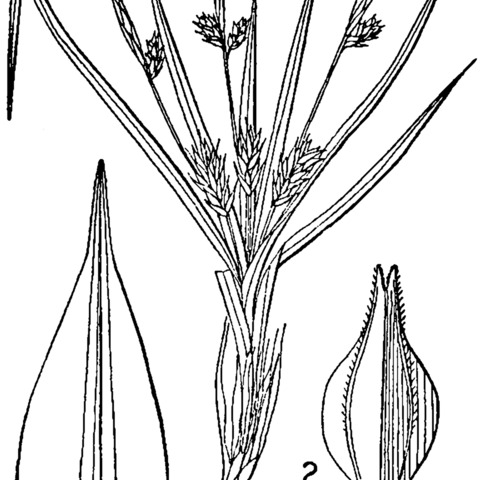Plants densely cespitose; rhizomes ascending to erect, reddish brown, 0–5 mm, stout. Culms 3–7.5(–18) cm, scabrous distally; bases (remnants of old leaves) weakly to strongly fibrous. Leaf blades pale green, greatly exceeding culms, 1–2.3(–3.8) mm wide, herbaceous, glabrous abaxially, strongly scabrous to papillose adaxially. Inflorescences with both staminate and proximal spikes; peduncles of basal spikes erect, short to elongate, slender; peduncle of staminate spikes 0.7–5.2(–12.3) mm; proximal nonbasal bracts scalelike, usually shorter than (occasionally equaling) inflorescences. Spikes: proximal pistillate spikes 2–5 (basal spikes 1–3); cauline spikes overlapping with staminate spikes, with (1–)4–12 perigynia; staminate spikes 4.6–13 × 0.7–2.2 mm. Scales: pistillate scales reddish brown with narrow white margins, ovate, 2.8–3.9 × 1.5–1.9 mm, equaling or exceeding perigynia, apex acute to acuminate; staminate scales ovate to lanceolate, 3.5–5.1 × 1.1–2.2 mm, apex obtuse to acute. Anthers 1.7–2.2 mm. Perigynia pale green to pale brown, veinless, obovoid to globose, rarely ellipsoid, obtusely trigonous in cross section, 2.2–3.2 × 1–1.4 mm; beak straight, pale green to pale brown, strongly 2-edged, 0.4–1 mm, weakly ciliate-serrulate, apical teeth 0.1–0.2 mm. Stigmas 3. Achenes brown, ellipsoid, obtusely trigonous in cross section, 1.4–1.7 × 1–1.3 mm. 2n = 30, 32.
More
Densely cespitose and basally fibrillose; stems 5–10(–20) cm, much surpassed and often concealed by the lvs; lvs 1–5 mm wide; staminate spike terminal, 5–10 mm, sometimes with a short pistillate spike just beneath it, the subtending bract of this pistillate spike scale-like and shorter than the staminate spike; 1–3 near-basal, short pedunculate pistillate spikes 4–10 mm generally associated with each flowering stem, ± removed from the terminal staminate spike; pistillate scales acute to short-cuspidate, about as long and wide as the greenish perigynia; perigynia 2.5–4 mm, finely hairy or glabrous, obovoid, 2-keeled above, tipped with a prominent, 2-edged, often curved, bidentate beak 0.5–1.5 mm; achene rounded-trigonous; 2n=32. Dry to moist soil, in shade or sun; Nf. to B.C., s. to Va., Ga., Mo., and Tex. (C. abdita; C. rugosperma, with a relatively long perigynium-beak; C. tonsa)

